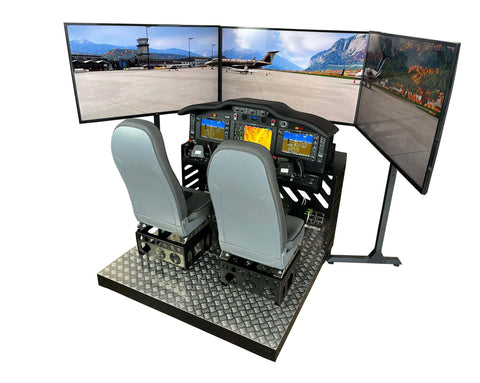Interested in getting started with creating your own home flight simulator? Awesome! It’s a great investment for experienced pilots, student pilots, and aviation enthusiasts alike. We’re going to give you a basic outline of all the components normally needed to create the best experience. Time for take-off!
Think about which aircraft you fly the most
It’s best to be realistic about what aircraft you fly the most. To get the most bang for your buck, you’d be wise to factor in aircraft configurations prior to making your first purchase.
Looking at the big picture first, let’s review the major components.
Gaming PC
Starting with one of the most expensive and important components is the gaming PC. Flight sim software requires a high performing PC. The power needed has continued to rise as the softwares have continued to develop. Performance will vary based on the CPU and graphics card. Not sure what to look for? Here’s a great article.
Software
Next you obviously need a simulation engine. For pilots and enthusiasts who want versatile and realistic simulations of general and commercial aviation, Prepar3D®, X-Plane, and Microsoft Flight Simulator are popular options.
Prepar3D
It’s one of the most popular flight simulators and it’s been on the market for a very long time. It’s actually a Microsoft FSX at the core which was acquired by Lockheed Martin and has improved significantly since then.
The big advantage of this simulator is that it has a huge user base and 3rd party plugins/aircrafts available.
The biggest disadvantage is that it was never built to be interfaced with hardware and the possibility of being able to interface with it hugely depends on the 3rd party aircraft developer.
Unfortunately, a lot of developers don’t put any effort into making the interfacing possible and therefore for many aircrafts, it’s impossible to use hardware to a full extent.
X-Plane
It’s a quite modern flight simulator built by a huge aviation lover, Austin Meyer.
It’s ready to interface out of the box and the default aircrafts that come with the sim are of very decent quality.
Because of the ease of interfacing with, very realistic flight model, and good performance on modern PCs, it’s our flight simulator of choice.
Microsoft Flight Simulator 2020
Microsoft Flight Simulator is the most popular simulator in the world and it’s been on the market since 1982.
Recently Microsoft together with Asobo Studios revived the series by releasing the MSFS 2020. The main improvement in the sim is definitely the graphics. It’s just eye candy and it looks fantastic.
Since they use satellite images to generate the scenery it looks exactly like real life. It’s definitely the best simulator of choice when it comes to VFR flying.
Unfortunately, deep at its core it’s still a very old FSX with all its quirks and issues it can be difficult to interface with. That being said, we strongly believe that if Asobo continues to improve it, it can become a solid platform for flight simulation in the future.
Screens/Monitors
Depending on the space you have available, there’s a variety of options for monitors. Better quality like 4K will give you a good field of view which is important. You can also set up multiple screens to show side views. Curved monitors are also a great option recently.
For a desktop setup we highly recommend 43” curved monitors. They are more and more affordable and they give you a decent field of view and they just look fabulous!

Hardware
Hardware is very important in creating an accurate and realistic flying experience from home. A standard computer mouse can be sufficient at first, but we highly suggest upgrading that to get the most out of the experience. Especially for training and muscle memory. Once you begin performing maneuvers, a quality yoke, throttle, and a set of rudder pedals will help immensely.
There are quite a lot of options available on the market, but those are our favorites:
- Brunner Elektronik
It’s the highest quality available on the market. All of their flight controls are control loaded, meaning that they simulate the actual forces on the control surfaces. It just can’t get more realistic than that! - ELITE
They have been on the market since 1987 which speaks for itself. They offer great quality flight controls. - Virtual Fly
Their controls are not control loaded, but they are made out of very high quality materials and are one of the best choices for serious flight simulation. - Honeycomb Aeronautical
One of the most popular options these days amongst home flight simmers. They offer a great value for the price. Unfortunately they’re hard to get because they are usually sold out.
Plug and play options
If your goals with a home simulator are specific to flying, then an all-in-one desktop device might be the best choice.
Plug and play options are great for the following:
- To start flying without configuring or installing anything
- To have preset flight scenarios
- Quickly set up a home flight experience
All of the hardware we provide at Aviatek Flight Simulators is plug & play.
If you generally fly an aircraft that has a G1000 suite, we have a 1:1 replica G1000 hardware unit and a G1000 desktop trainer.
 |  |
Additionally for those who fly the Cessna Citation Mustang we have an array of devices to fit their needs from an entire trainer based on the Mustang cockpit to plug & play options like the landing gear or lightning panel.
Questions?
Reach out to us if you have questions regarding how you can build your ideal simulator. And if you need technical support with setting up any of your Aviatek products just let us know!

